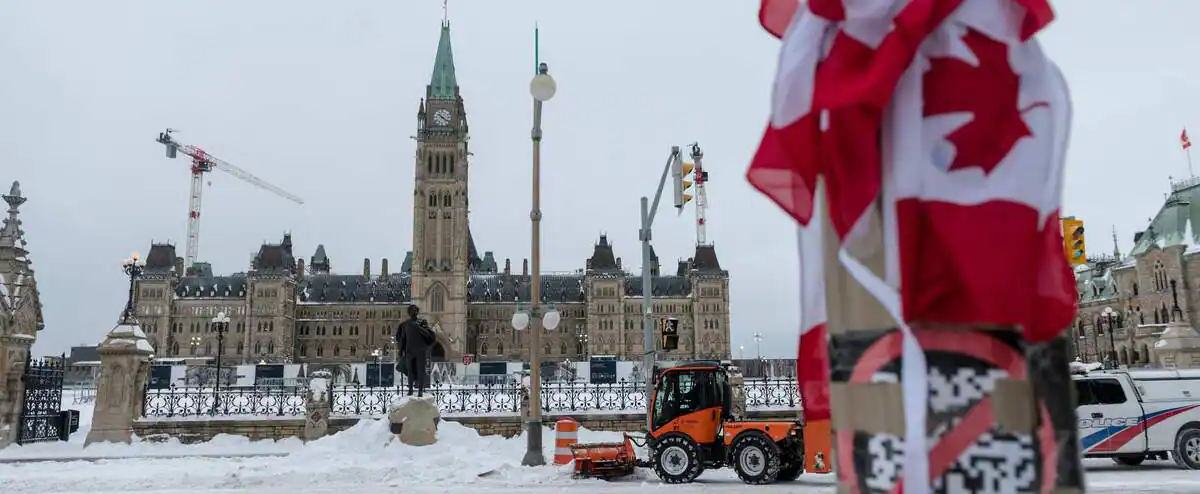A capital and bridges paralyzed against a call for “freedom”: for more than three weeks, Canada has been shaken by an unprecedented wave of protest against health measures.
• Read also: An investigation into the dismantling of the demonstration in Ottawa
• Read also: Ottawa mayor wants to sell vehicles seized by police
• Read also: Convoy of freedom: “it’s not over, we’re relocating”
Back on the main stages of this movement.
Canadian truckers opposed to the obligation to be vaccinated against COVID-19 to cross the Canada-US border unite at the end of January to form a so-called “freedom” convoy.
Some take the road from Vancouver, on the Pacific coast, to the federal capital some 4,400 km to the east. As they advanced, the convoy grew in size and gained supporters.
January 29
Canadian flags on the shoulders, slogans against Justin Trudeau and for “freedom of choice”: 8,000 demonstrators and hundreds of trucks made their voices and horns heard on January 29 on Parliament Hill in Ottawa.
Several hundred of them decide to stay put, erecting food stalls, tents and even more unusual structures such as an inflatable jacuzzi.
February 6
A week later, hundreds of trucks are still filling the streets of central Ottawa. Shops and restaurants are closed. The trucks sound their horns night and day in this usually very calm city.
Judging the situation “out of control”, the mayor of the city Jim Watson ended up declaring a state of emergency on February 6. In his wake, the police chief evokes a “state of siege” and calls for “additional resources”.
February 7
While all eyes are on Ottawa, the demonstrators choose to increase the pressure by blocking the border axes with the United States. Protesters come to settle on February 7 on the Ambassador Bridge in Ontario.
The blocking of this crucial land road axis for trade between the two North American neighbors has almost immediate economic repercussions, particularly for the automotive industry. Some factories are forced to temporarily suspend production.
After three days of paralysis, the White House is urging Canada to use “federal powers” to free the bridge and restore traffic.
February 11th
The two most important demonstrations – the occupation of Ottawa and the blocking of the Ambassador Bridge – taking place on its territory, the province of Ontario in turn declared a state of emergency on February 11.
“We will take all necessary measures to ensure the reopening of the border. And to the beleaguered residents of Ottawa, I say, we’re going to make sure you can get back to normal life as soon as possible,” said Premier Doug Ford.
February 14th
From then on, protesters risk hefty fines and up to a year in prison.
Faced with the impasse, Prime Minister Justin Trudeau exceptionally announced on February 14 that Canada will use its Emergency Measures Act to put an end to demonstrations and blockages.
Used only once in peacetime, this provision allows the federal government to resort to “extraordinary measures” in times of “national crisis”.
In the following days, the bank accounts of some demonstrators will be frozen, and the police have additional powers to put an end to the mobilization.
February 18
After three weeks of occupation, hundreds of police arrived on Friday February 18 to begin dislodging the demonstrators.
Saturday, the tension goes up a notch. Protesters throw smoke bombs towards the police who are supported by armored vehicles and snipers.
Spraying the protesters with pepper spray, destroying the windows of the vehicles in which some have taken refuge, the authorities manage to take back the main street in front of the Canadian Parliament in the afternoon and surround it with a fence.
During this muscular police intervention, nearly 200 people were arrested. On Sunday, calm returned to the snow-covered streets of central Ottawa, with only a handful of protesters still defying the police.
